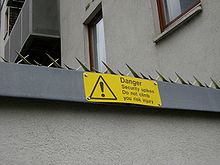For other uses, see Security (disambiguation).
|
|
|

X-ray machines and metal detectors are used to control what is allowed to pass through an airport security perimeter.
As noted by the Institute for Security and Open Methodologies (ISECOM) in the OSSTMM 3, security provides "a form of protection where a separation is created between the assets and the threat." These separations are generically called "controls," and sometimes include changes to the asset or the threat.[1]
Contents
Perceived security compared to real security
Perception of security may be poorly mapped to measureable objective security. For example, the fear of earthquakes has been reported to be more common than the fear of slipping on the bathroom floor although the latter kills many more people than the former.[2] Similarly, the perceived effectiveness of security measures is sometimes different from the actual security provided by those measures. The presence of security protections may even be taken for security itself. For example, two computer security programs could be interfering with each other and even cancelling each other's effect, while the owner believes s/he is getting double the protection.Different scenarios also give rise to the context in which security is maintained:
- With respect to classified matter, the condition that prevents unauthorized persons from having access to official information that is safeguarded in the interests of national security.
- Measures taken by a military unit, an activity or installation to protect itself against all acts designed to, or which may, impair its effectiveness.
Perception of security can also increase objective security when it affects or deters malicious behavior, as with visual signs of security protections, such as video surveillance, alarm systems in a home, or an anti-theft system in a car such as a vehicle tracking system or warning sign.
Since some intruders will decide not to attempt to break into such areas or vehicles, there can actually be less damage to windows in addition to protection of valuable objects inside. Without such advertisement, a might, for example, approach a car, break the window, and then flee in response to an alarm being triggered. Either way, perhaps the car itself and the objects inside aren't stolen, but with perceived security even the windows of the car have a lower chance of being damaged, increasing the financial security of its owner(s).
However, the non-profit, security research group, ISECOM, has determined that such signs may actually increase the violence, daring, and desperation of an intruder.[3] This claim shows that perceived security works mostly on the provider and is not security at all.[4]
It is important, however, for signs advertising security not to give clues as to how to subvert that security, for example in the case where a home burglar might be more likely to break into a certain home if he or she is able to learn beforehand which company makes its security system.
Categorizing security
There is an immense literature on the analysis and categorization of security. Part of the reason for this is that, in most security systems, the "weakest link in the chain" is the most important. The situation is asymmetric since the 'defender' must cover all points of attack while the attacker need only identify a single weak point upon which to concentrate.|
IT realm |
Physical realm |
Political Monetary |
- Aviation security is a combination of material and human resources and measures intended to counter unlawful interference with aviation.
- Operations Security (OPSEC) is a complement to other "traditional" security measures that evaluates the organization from an adversarial perspective.[5]
Security concepts
Certain concepts recur throughout different fields of security:- Assurance - assurance is the level of guarantee that a security system will behave as expected
- Countermeasure - a countermeasure is a way to stop a threat from triggering a risk event
- Defense in depth - never rely on one single security measure alone
- Exploit - a vulnerability that has been triggered by a threat - a risk of 1.0 (100%)
- Risk - a risk is a possible event which could cause a loss
- Threat - a threat is a method of triggering a risk event that is dangerous
- Vulnerability - a weakness in a target that can potentially be exploited by a security threat
Security management in organizations
In the corporate world, various aspects of security were historically addressed separately - notably by distinct and often noncommunicating departments for IT security, physical security, and fraud prevention. Today there is a greater recognition of the interconnected nature of security requirements,[6] an approach variously known as holistic security, "all hazards" management, and other terms.Inciting factors in the convergence of security disciplines include the development of digital video surveillance technologies (see Professional video over IP) and the digitization and networking of physical control systems (see SCADA).[7][8] Greater interdisciplinary cooperation is further evidenced by the February 2005 creation of the Alliance for Enterprise Security Risk Management, a joint venture including leading associations in security (ASIS), information security (ISSA, the Information Systems Security Association), and IT audit (ISACA, the Information Systems Audit and Control Association).
In 2007 the International Organisation for Standardization (ISO) released ISO 28000 - Security Management Systems for the supply chain. Although the title supply chain is included, this Standard specifies the requirements for a security management system, including those aspects critical to security assurance for any organisation or enterprise wishing to management the security of the organisation and its activities. ISO 28000 is the foremost risk based security system and is suitable for managing both public and private regulatory security, customs and industry based security schemes and requirements.


No comments:
Post a Comment